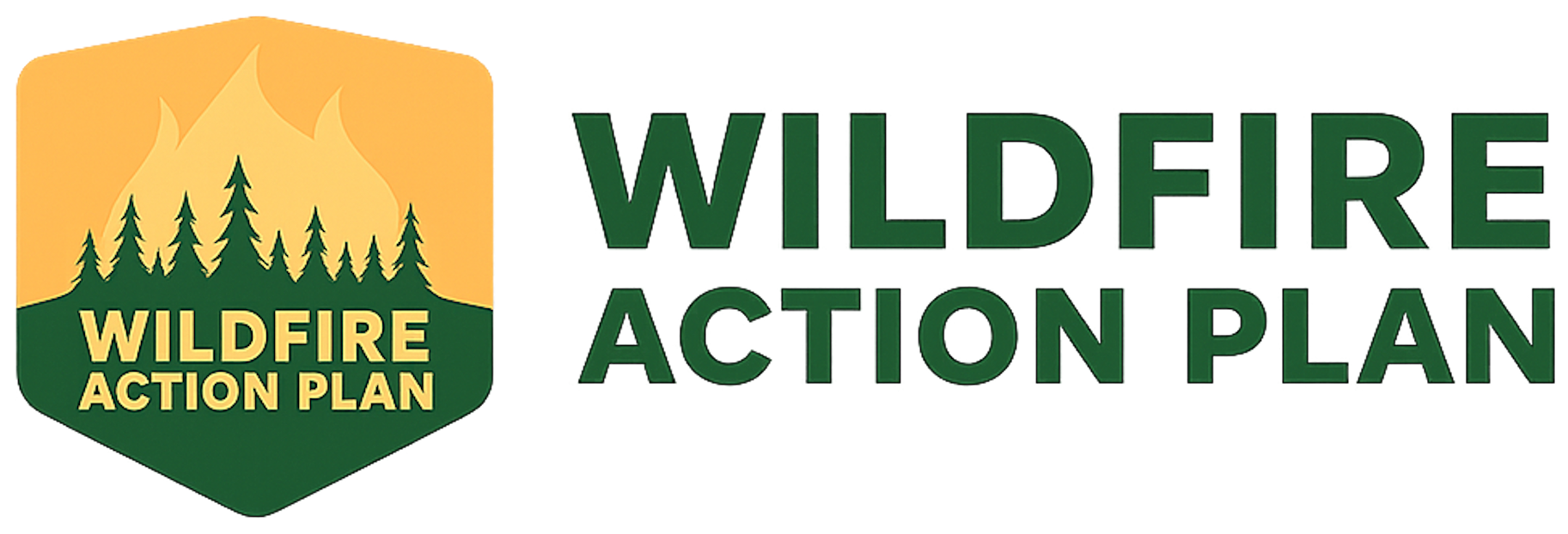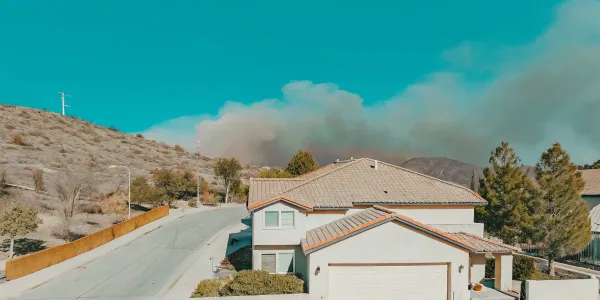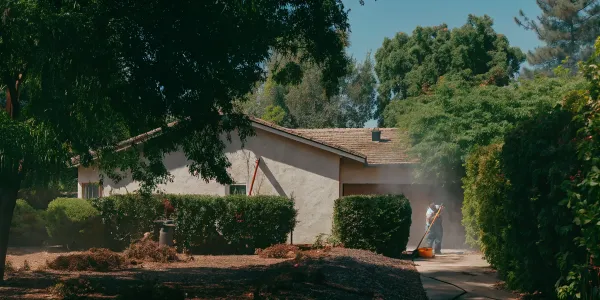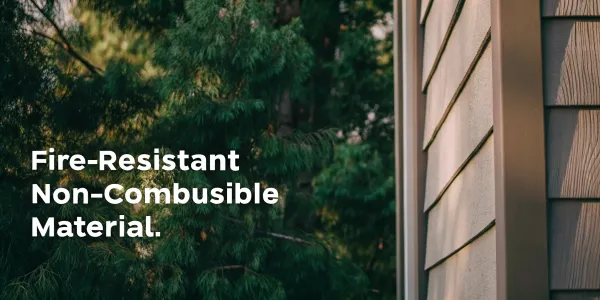Your Custom Wildfire Action Plan for Northern California
Create a custom wildfire action plan Northern California families can trust. Get practical steps to protect your home, stay insured, and keep your family safe.
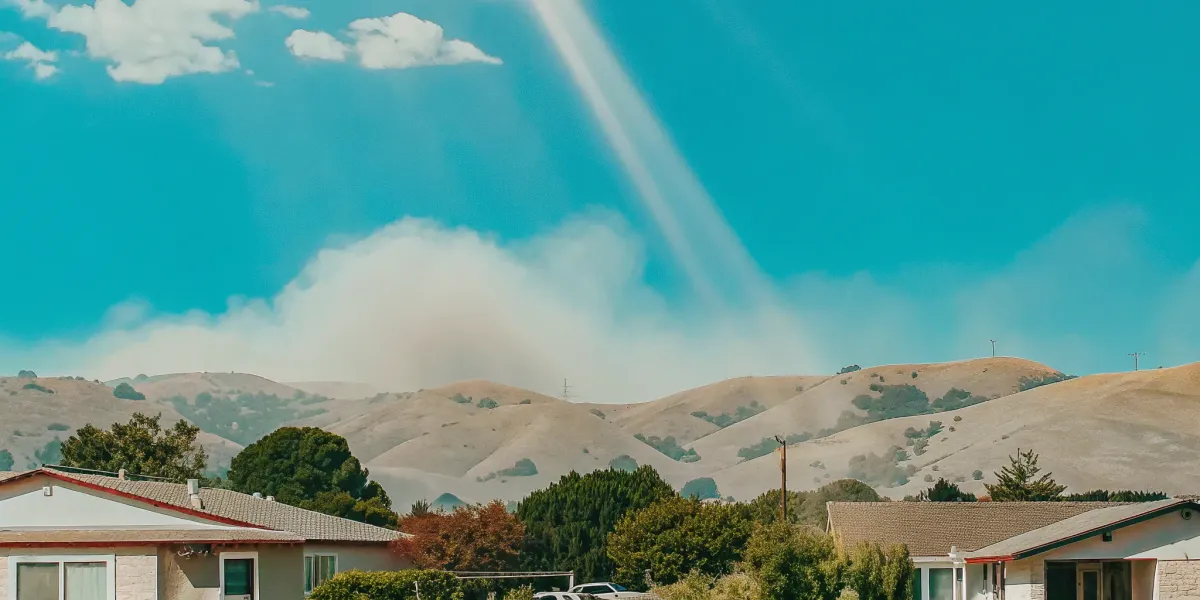
When you think of a wildfire, you probably picture a massive wall of flames. But the truth is, most homes aren't destroyed by the main fire front. They're lost to a much smaller, more insidious threat: embers. These tiny, wind-blown pieces of burning debris can travel a mile or more, landing in gutters, under decks, and entering vents to ignite a house from within. This is actually good news, because it means you have far more control than you think. By focusing on preventing ember ignition, you can dramatically increase your home’s chances of survival. We’ll show you the specific steps that matter most, helping you build a custom wildfire action plan Northern California focused on defeating this primary threat.
Key Takeaways
- Prioritize a Two-Layer Property Defense: Your home's survival depends on both managing the surrounding landscape and strengthening the structure itself. Focus on creating 100 feet of defensible space and hardening your home against embers with upgrades like Class A roofing and covered vents.
- Create and Practice Your Escape Plan: A well-rehearsed evacuation plan replaces panic with clear action. Map multiple escape routes, establish a family communication system, and have go-bags ready for every person and pet. Regular practice ensures everyone knows exactly what to do.
- Make Preparedness an Ongoing Habit: Your wildfire plan is only effective if it's current. Schedule bi-annual reviews to update contacts and supplies, practice your evacuation drills, and re-evaluate your property's risk to ensure your plan adapts to life's changes.
What Are the Real Wildfire Risks in Northern California?
Living in Northern California means accepting that wildfire is a part of the landscape. But accepting risk isn’t the same as feeling powerless. The key is to understand the specific threats to your home and community so you can take targeted, effective action. It’s not about the giant wall of flames you see on the news; the real danger is often smaller and more widespread. Embers, for example, can travel a mile or more ahead of a fire, igniting homes far from the main blaze. Understanding these nuances is the first step toward protecting your family and property.
Know Your Local Risk Factors
Wildfire risk isn’t uniform. It changes based on your specific location, the surrounding vegetation, local weather patterns, and even the slope of your land. As fires become more frequent, local authorities are urging residents in high-risk areas to create defensible space and harden their homes against embers. Your responsibility starts with knowing your property’s unique vulnerabilities. Are you in a designated Fire Hazard Severity Zone? What type of vegetation is nearby? Answering these questions helps you move from general anxiety to a focused, actionable strategy. A clear understanding of your local risk is the foundation of a solid preparedness plan.
How Wildfire Risk Affects Your Home Insurance
The changing wildfire landscape has put immense pressure on the home insurance market. Insurers are no longer just looking at your ZIP code; they’re scrutinizing individual properties for specific risks. Many homeowners are shocked to learn their policy may not fully cover the cost of rebuilding, leaving them underinsured when they need it most. Insurers are focused on one primary threat: embers. They want to see that you’ve taken concrete steps to prevent wind-blown embers from igniting your home. This is why home hardening isn’t just about safety—it’s about maintaining your insurability in a challenging market.
Debunking Common Wildfire Safety Myths
Two dangerous myths prevent people from preparing for wildfires: that defensible space doesn’t work and that insurance will cover everything. The reality is that most homes are destroyed by embers landing on or near the house, igniting flammable materials like dry leaves in a gutter or a woodpile stacked against a wall. This is a problem you can directly address. Proactive measures like clearing debris and installing ember-resistant vents make a huge difference. Relying solely on insurance is a gamble, especially with rising non-renewals. Taking control of your property’s defense is the most reliable way to protect your investment and create a personalized wildfire action plan that truly works.
Defend Your Home: A Step-by-Step Strategy
Protecting your home from wildfire isn’t about a single, heroic effort; it’s a series of deliberate, strategic actions. Think of it as creating multiple layers of defense that work together to give your property the best possible chance of survival. This approach involves managing the landscape around your home—what experts call defensible space—and strengthening the structure of your house itself through home hardening. Taking these steps not only makes your home safer but also makes it more attractive to insurers, which is critical in California’s challenging market. By focusing on proven strategies, you can take control and significantly reduce your home’s vulnerability.
Define Your Three Zones of Defensible Space
Defensible space is the buffer you create between your home and the surrounding vegetation. This area is designed to slow or stop a wildfire’s spread, giving firefighters a safer space to defend your property. California law requires homeowners to maintain this space up to 100 feet from their homes.
You can break this down into three manageable zones:
- Zone 0 (The Ember-Resistant Zone, 0-5 feet): This is your most critical area. Remove all flammable materials, including mulch, dead leaves, and outdoor furniture. Use non-combustible materials like gravel or concrete here. This zone is your last line of defense against embers, which are the leading cause of home ignition during a wildfire.
- Zone 1 (The Lean, Clean, and Green Zone, 5-30 feet): Clear away dead plants, leaves, and pine needles. Create space between trees and remove lower branches to prevent fire from climbing into the canopy.
- Zone 2 (The Reduced Fuel Zone, 30-100 feet): Thin out vegetation, remove dead trees and shrubs, and keep grass mowed to four inches or less. The goal here isn’t to clear the land completely but to reduce the density of fuel that a fire could consume. You can find detailed guidance on creating these zones from CAL FIRE.
Harden Your Home: Key Steps That Matter to Insurers
While defensible space manages the landscape, home hardening focuses on making the physical structure of your house more fire-resistant. Most homes are lost to wildfire not from direct flames, but from wind-blown embers that find a way inside or land on flammable materials. Insurers pay close attention to home hardening measures because they directly address this primary threat.
Key upgrades include:
- Roofing: Install a Class A fire-rated roof, made of materials like composite shingles, metal, or tile.
- Vents: Cover all attic, foundation, and eave vents with 1/8-inch metal mesh to block embers from entering.
- Windows: Upgrade to dual-paned windows with tempered glass, which are more resistant to breaking from heat.
- Siding and Decks: Use non-combustible materials like fiber-cement siding and composite decking.
These improvements are some of the most effective ways to prepare your home and demonstrate to your insurer that you are actively reducing your risk.
Make Insurance-Friendly Property Upgrades
Every home hardening and defensible space action you take is a step toward keeping your property insurable. Insurers are looking for proactive homeowners who are managing their wildfire risk. When you make these upgrades, document everything. Take before-and-after photos and keep receipts for all work and materials. You can present this documentation to your insurance agent as proof of your mitigation efforts.
It’s also a good time to review your homeowner’s policy. Many people mistakenly believe their insurance will automatically cover the full cost of rebuilding. In reality, rising construction costs mean many homeowners are underinsured. Confirm that your coverage limits are high enough to rebuild your home in today’s market. A comprehensive Wildfire Action Plan can help you track your upgrades and organize your important insurance documents in one place.
Follow a Year-Round Maintenance Checklist
Wildfire preparedness is an ongoing commitment, not a one-time project. Vegetation grows back, leaves fall, and new vulnerabilities can appear over time. A year-round maintenance schedule helps you stay on top of tasks and ensures your defenses are always ready.
Break down your tasks by season:
- Spring: Clear dead vegetation and create defensible space before fire season peaks.
- Summer: Water plants and trees near your home to keep them healthy and less flammable. Re-check your defensible space zones.
- Fall: Clean leaves and needles from your roof, gutters, and the base of your home (Zone 0).
- Winter: Prune trees and shrubs. Inspect your home for any needed repairs to your roof, siding, or vents.
Regularly practicing your evacuation plan and checking your emergency kits should also be part of this routine. Consistency is key to maintaining a fire-safe home.
Create Your Family's Evacuation Plan
When an evacuation order is issued, you may only have minutes to leave. In that high-stress moment, confusion is your enemy. A well-defined evacuation plan is one of the most critical tools you have to protect your family. It replaces panic with a clear, rehearsed set of actions, ensuring everyone knows what to do, where to go, and how to stay in touch. This isn't just about having a destination in mind; it's about mapping out the specific steps to get there safely.
Your plan should be tailored to your family's unique situation, accounting for everyone from young children to elderly relatives and pets. Think through the logistics now so you don’t have to improvise during an emergency. Where will you meet if you get separated? Who is responsible for grabbing the go-bags? Which routes will you take if your primary exit is blocked? Answering these questions ahead of time transforms a chaotic scenario into a manageable process. A strong plan is your roadmap to safety, and the Wildfire Action Plan tool can help you organize every detail in one place.
Set Up a Communication Plan
During a wildfire, cell towers can become overloaded or damaged, making communication difficult. Don't rely on being able to call each other. Instead, establish a clear family communication plan. Designate a friend or relative who lives out of state as your central point of contact. It's often easier to make a long-distance call than a local one during a regional emergency. Make sure everyone in your family has this person’s number saved in their phone and written down in their go-bag. Also, create a group text with all family members for quick updates. This simple system ensures everyone can check in and receive information, even if you get separated.
Map Multiple Escape Routes
Your usual route home from work or school might be blocked by fire or traffic during an evacuation. Relying on a single escape route is a dangerous mistake. Sit down with your family and a map of your area to identify at least two or three different ways out of your neighborhood and your town. Drive these routes so everyone is familiar with them. You should also designate two emergency meeting places: one just outside your immediate neighborhood (like a specific park or grocery store parking lot) and another outside your town in case of a wider evacuation. Practicing this plan regularly ensures everyone can act quickly and confidently when it matters most.
Plan for Family Members with Special Needs
Every family’s evacuation plan needs to account for the specific needs of its members. Children, seniors, and individuals with disabilities or medical conditions require special consideration. Think about what they might need to evacuate safely. Does someone rely on medical equipment that requires power? Are there specific medications that need to be packed? Who will be responsible for assisting a family member with mobility challenges? Assigning these roles and preparing necessary supplies in advance is essential. A successful wildfire action plan leaves no one behind and ensures every person’s needs are met during a stressful evacuation.
Don't Forget Your Pets and Livestock
Your animals depend on you for their safety. Your evacuation plan must include clear provisions for your pets and any livestock. For household pets, have carriers, leashes, and go-bags with food, water, and medications ready. Research pet-friendly hotels or shelters outside your area ahead of time, as many emergency shelters cannot accommodate animals. For livestock, the planning is more complex and must be done far in advance. Arrange for trailers and identify safe locations where you can take them. A complete Wildfire Action Plan ensures that every member of your family, furry or otherwise, has a clear path to safety.
Coordinate with Your Neighbors
Wildfire preparedness is a community effort. What your neighbors do can affect your safety, and vice versa. Talk to them about your evacuation plans and share contact information. In a fast-moving emergency, you can provide each other with critical updates. If you have elderly neighbors or families with young children, agree to check on each other when an evacuation warning is issued. Strong neighborhood networks are invaluable during a crisis. Sharing your plan can encourage others and contribute to community-wide wildfire preparedness, making everyone safer.
Assemble Your Go-Bags and Emergency Kits
When an evacuation order comes, time is the one thing you don’t have. The stress and urgency of the moment can make it nearly impossible to think clearly about what to pack. That’s why preparing your emergency kits and go-bags ahead of time is one of the most critical steps you can take. Having everything organized and ready to grab gives you control in a chaotic situation, allowing you and your family to leave quickly and safely. Think of it as your evacuation insurance policy—a tangible plan that reduces panic and ensures you have what you need to get through the first few days.
Your goal is to create a system of kits that covers you at home and on the road. This includes a personal "go-bag" for each family member, a larger emergency supply kit for the household, and a dedicated kit for your car. These kits should contain everything from essential documents and medications to food, water, and basic tools. By taking the time to assemble these kits now, you’re not just packing supplies; you’re building peace of mind. You’re creating a clear, actionable path forward so that when you need to act, you can do so with confidence instead of fear.
Remember the "6 P's" of Evacuation
To simplify what to prioritize during a sudden evacuation, emergency responders often refer to the "6 P's." This simple memory aid from CAL FIRE helps you focus on the absolute essentials when minutes count.
Here’s what to remember:
- People & Pets: Your family’s safety is the top priority. This includes having a plan for your pets, with carriers, leashes, and food ready to go.
- Papers: Important documents like insurance policies, passports, and birth certificates.
- Prescriptions: A supply of necessary medications, eyeglasses, and other medical items.
- Pictures: Irreplaceable photos and personal mementos.
- Personal Computer: Laptops, external hard drives, and other critical data storage.
- 'Plastic' & Cash: Credit cards, ATM cards, and some cash.
Gather Your Important Documents
Your important papers are difficult, if not impossible, to replace. Gather them now and store them in a single, accessible location. Your document kit should be in a portable, fire-resistant, and waterproof safe or lockbox that you can grab in a hurry. Include originals of birth certificates, social security cards, passports, and property deeds. Don’t forget copies of your insurance policies, vehicle titles, and recent financial statements. It’s also a smart idea to create digital backups. Scan your documents and save them to a secure cloud service or an encrypted USB drive that you keep in your go-bag. This redundancy ensures you can access your critical information no matter what happens.
Pack Your Car Kits
You might not be home when an evacuation is ordered, or you could get stuck in heavy traffic while leaving. That’s why keeping an emergency supply kit in your car is so important. This kit should have enough supplies to keep you and your family safe and comfortable for at least 72 hours. Be sure to include bottled water, non-perishable snacks, a first-aid kit, and a portable phone charger or power bank. Also pack blankets, a flashlight with extra batteries, and physical maps of your area in case cell service and GPS are unavailable. Check and refresh your car kit every six months to ensure food isn't expired and supplies are in good condition.
Prepare Your Family's Go-Bags
Every person in your household should have their own personalized go-bag. This ensures everyone’s individual needs are met and gives older children a sense of responsibility. Each bag should be a backpack that’s easy to carry and contains essentials to last for several days. The American Red Cross provides excellent checklists to get you started. Pack a change of clothes, sturdy shoes, toiletries, and any personal medications. For kids, include a favorite book, a small game, or a comfort item to help reduce stress. Don’t forget to add high-energy snacks, a reusable water bottle, and a list of emergency contact numbers. Keep these bags somewhere you can grab them instantly, like a closet near your main exit.
Stock Your Emergency Tools
In addition to your go-bags, you need a small collection of emergency tools that are easily accessible. First, make sure you have one or more all-purpose fire extinguishers and that every adult in the house knows where they are and how to use them properly. Check the expiration dates and pressure gauges regularly. Second, you need to know how to shut off your home’s main utilities. Locate your gas, water, and electricity shut-offs and keep any necessary tools, like a wrench for the gas line, stored nearby. Practice the shut-off procedures so you can do them quickly if emergency officials instruct you to. This simple preparation can prevent further damage to your home, like a gas leak or flooding.
Keep Your Wildfire Plan Current
Creating a wildfire plan is a huge first step, but it’s not a one-and-done task. Your plan needs to be a living document that adapts to changes in your family, your property, and the environment around you. Wildfire risk isn't static, and neither is your life. A new baby, an aging parent moving in, or even road construction on your primary evacuation route can make an old plan obsolete. The most effective plans are the ones that are reviewed and practiced regularly.
Think of it like maintaining your car. You don't just buy it and hope it runs forever; you get oil changes and check the tire pressure. Your wildfire plan requires the same consistent attention to keep your family safe when it matters most. When an evacuation order comes, you won't have time to second-guess your strategy or search for outdated information. Keeping your plan current ensures that when you need to act, you can do so with confidence and clarity, turning preparedness into protection. The following steps will help you build a routine around maintaining your plan, making it a reliable tool for years to come.
Sign Up for Local Emergency Alerts
During a wildfire, information is your most valuable asset. Official sources are the only way to get timely, accurate updates on fire movement and evacuation orders. Don't rely on social media or word-of-mouth. Instead, make sure every adult in your household is signed up for alerts from your county's emergency services. These systems, often called Nixle or Everbridge, send notifications directly to your phone.
You should also enable Wireless Emergency Alerts (WEAs) on your smartphone, which are sent by government agencies for imminent threats. Taking a few minutes to sign up for local alerts is one of the most important things you can do. It ensures you have the information you need to put your plan into action at the earliest possible moment.
Practice Your Plan Together
A plan on paper is just an idea. A practiced plan is a life-saving skill. The stress and panic of an actual evacuation can make it hard to think clearly, which is why muscle memory is so important. At least twice a year, run through your evacuation plan with your entire family. Time yourselves packing your go-bags and loading the car. Drive your primary and secondary escape routes so everyone is familiar with them.
Make it a family activity. Talk through the communication plan so your kids know who to call if you get separated. Practice gathering your pets and getting them into their carriers. These drills help identify weaknesses in your plan and build the confidence your family needs to act decisively during an emergency.
Use the Right Tools to Stay Organized
A three-ring binder with printed checklists is a good start, but what if you have to leave in a hurry and forget it on the counter? Modern preparedness means having your plan accessible from anywhere. Using a digital tool helps you keep all your critical information—evacuation routes, contact lists, go-bag checklists, and important document locations—in one secure, cloud-based location.
This ensures that anyone in the family can access the plan from their phone. A dedicated tool like the Wildfire Action Plan is designed specifically for this purpose. It guides you through creating a comprehensive plan and keeps it organized, so you can focus on safety, not shuffling papers, when seconds count.
Schedule Regular Plan Reviews
Set a recurring date on your calendar to review your wildfire plan. A good rhythm is to do it twice a year: once in the spring before fire season ramps up, and again in the fall. During your review, check for anything that has changed. Have phone numbers been updated? Do you need to add new medications to your go-bag? Have any of your emergency supplies expired?
This is also a great time to check in with your designated out-of-state contact and your local emergency meeting spots. Share key parts of your plan with trusted neighbors. Community preparedness is a powerful force, and knowing your neighbors' plans can help everyone stay safer.
Re-evaluate Your Risk Each Season
Your property's wildfire risk can change from one year to the next. A severe drought can make the landscape more flammable, or a neighbor might have let their defensible space become overgrown. Each season, take a walk around your property with a critical eye. Look for new vulnerabilities and assess whether your home hardening and defensible space are still adequate.
Stay informed about your community's overall risk level. Local fire departments and agencies like CAL FIRE often provide updated risk maps and assessments. As wildfire behavior becomes more extreme, your preparedness efforts must keep pace. An annual risk assessment ensures your plan is based on current conditions, not last year's reality.
Related Articles
- Wildfire Season: Why It's Now a Year-Round Threat
- How to Get CA Home Insurance in High Fire Risk Areas
- Protect Your Home: Top 10 Wildfire Prevention Measures
Frequently Asked Questions
This all feels overwhelming. What's the single most important thing I can do to start? I completely understand that feeling. The best place to begin is with Zone 0, the five-foot area immediately surrounding your home. Clear out all flammable materials like bark mulch, dead leaves, and woodpiles. This simple, focused action creates a non-combustible barrier that is your home's most critical defense against embers, which cause most homes to ignite during a wildfire.
Why is there so much focus on embers instead of the main fire? It’s a common misconception that a giant wall of flames is what destroys most homes. In reality, the primary threat comes from embers—small, wind-blown pieces of burning debris that can travel a mile or more ahead of the fire. These embers are like thousands of tiny sparks searching for something flammable to land on, such as dry leaves in a gutter or a wicker patio chair. By hardening your home and maintaining your defensible space, you are directly addressing this number one cause of home loss.
Will home hardening and defensible space guarantee my home's survival? While no one can offer a 100% guarantee in a severe wildfire, taking these steps dramatically increases your home's chances of survival. Creating defensible space can slow a fire's approach, and hardening your home makes it far more resistant to ignition from embers. These actions also create a safer environment for firefighters to defend your property if they have the chance. You are shifting the odds significantly in your favor.
My insurance company already sent me a non-renewal notice. Is it too late to make these changes? It is absolutely not too late. Facing a non-renewal is incredibly stressful, but it can also be a catalyst for action. Making these upgrades now not only makes your home safer but also strengthens your case when applying for new coverage. Document every improvement with photos and receipts. This shows potential insurers that you are a proactive homeowner who is actively managing your property's risk, which can make a real difference in today's tough insurance market.
How often should I really practice my evacuation plan? A plan is only useful if you can execute it under pressure. You should practice your evacuation plan with your entire family at least twice a year. This doesn't have to be an elaborate, all-day drill. It can be as simple as timing how long it takes to get everyone in the car with their go-bags and driving your planned escape routes. Regular practice builds muscle memory, reduces panic, and helps you identify any gaps in your plan before an emergency happens.
